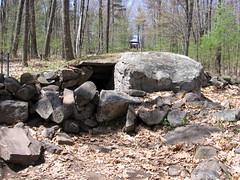Visiting sacred sites does necessarily mean the need to take a trip to the far-reaches of the world. Often, close to home, there are sacred and ancient sites that go unnoticed. Here are some that exist in New England, many of them accessible to the public.
Mystery Hill
| America's Stonehenge (Photo credit: dolescum) |
Folks in and around Salem, New Hampshire don't often speak of Mystery Hill,
unless asked directly about it. Like most people who live close by a historical
site or attraction, Mystery Hill has become commonplace. However, the site
offers visitors a step into the ancient past - a past where monoliths heralded
the change of seasons and witnessed ancient religious ceremonies.
Scientists and researchers believed that the 30-acres at Mystery Hill were
used by Bronze Aged Celts back as far as 3000 BP. Due to the lack of household
and gravesite artifacts, researchers believe the area was used chiefly for
ceremonies. People still use the monoliths as an accurate yearly calendar.
Many of the characteristics of Mystery Hill are unique. For instance, there
is an Oracle's chamber with a shaft that opens up underneath what is believed
to be an altar. When someone talks into the shaft, the voice is heard amplified
and distorted around the altar.
Vermont's Chambers
Vermont's Chambers
In Putney and South Woodstock, Vermont, there are several structures known as
"Calendar Chambers." These chambers are thought by some to have been
built by the ancient Celts due to inscriptions found on the stones. As
evidenced by their name, it appears that the purpose of the chambers is to use
them as calendars. Calendar II located in South Woodstock is aligned
to the solstice.
The Upton Beehive
The Upton Beehive
The controversy over who built the Upton chamber, a huge stone structure
resembling a beehive, is still hotly debated. Located in Upton, Massachusetts,
the structure has long been a focal point for archeologists and dreamers,
alike. Some researchers believe it is merely another root cellar created by a
colonial farmer. However, others believe that the structure could date back to
700 - 750 CE because it mimics accurately, structures found in Ireland built
around the same time. In addition, the entrance, which is long and narrow, is
aligned to the summer solstice, an architectural element found often in Ireland
and the Great Britain.
Gungywamp
| Gungywamp stone circle (Photo credit: Wikipedia |
Another archeological site that inspires myth and mystery is the
Gungywamp of Groton, Connecticut. The 100-acre site has artifacts and
structures that date as far back as 2000 BC. In addition to stone rings dating
back to between 280 and 630 C.E., Gungywamp has several "root"
cellars or calendar chambers, which accurately signal the equinoxes. Native
American artifacts have been found throughout the site, along with those of
early settlers.
Narragansett Tribal Village
Narragansett Tribal Village
Unfortunately, not all ancient sites are recognized as such. The discovery
of an entire First Peoples (Narragansett) village in Rhode Island several years
ago has cause great upheaval in the Rhode Island village. The site has been
described by archeologist as a "nationally significant" discovery is
on land slated for development. The significance of the find is that the entire
village, homes, granary, burial sites, etc. lie just under the surface.
Archeologists, who were asked to do a preliminary excavation of the site, found
numerous artifacts along with the remains of the village. They have estimated
that the village dates back to around the 1300's.
In May 2011, judges of the US Court of Appeals in Boston ruled against the
contractor; thereby opening the way for the First Peoples village to be
preserved.
Foxboro State Park
Foxboro State Park
 |
| F. Gilbert Hill hiking trail (Photo Credit: Wikipedia) |
A trip to Foxboro State Park leaves a visitor pondering the who, what, when,
where, why and how of the over 25 different rock formations found throughout
the park. The park is located on the highest area between Boston and
Providence. This coupled with the numerous rock formations, leads archeologist
and researchers to believe that the area within the park is "sacred
land."
There are six different types of rock formations found at the park - aligned
boulders, dolmens, standing stones, perched boulders, prayer seats, and stone
piles. Each of these formations alone sets an archeologist's heart thumping;
finding six different types in one location is overwhelming.
Theories as to who placed the stones in their present locations, why they
are there and what they were used for are open for discussion.
Long History
Long History
The New England states are among the oldest in the history of our country,
however, the ancient historic sites found in New England indicate that the
history of the area is much older than most of its European ancestors ever
realized.
Note: Many ancient historic landmarks are on private land.
If you wish to view them, please take the proper steps to gain permission.
Also, please do not move or remove stones from any of the sites. Remember, for
those who once used these sites, they are sacred. Please treat them with the
greatest respect.
Linda M. Rhinehart Neas, M.Ed. is a member of the TNS class of 2013. She is a writer, poet and educator. She lives in Western Massachusetts with her life-partner, Roger.



No comments:
Post a Comment